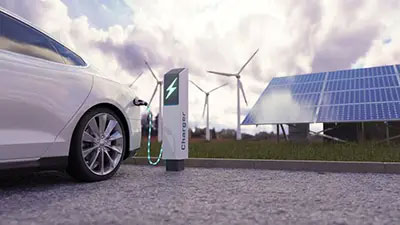Are EVs the New Edsels?

Since math can’t lie, here’s a look at how EVs are stacking up in terms of economic value. Economist Steve Moore recently compared EVs to the ill-fated Edsel, “one of the textbook marketing flops of all time.” (Millenials and Gen Z may have to do an internet search on this one.)
“All the automotive experts and Ford executives said it was a can’t-miss. Henry Ford (the car was named after his son) guaranteed hundreds of thousands of sales. But one big thing went wrong: Nobody ever bothered to ask car buyers what they thought of the new car,” he wrote.
“Given the all-in approach to electric vehicles at Ford and General Motors, it’s clear that Detroit never got the message.”
The main difference between the Edsel of the 1950s and EVs of the 21st century, however, is that taxpayers didn’t have to fork over hundreds of billions of dollars when the Edsel flopped.
The True Cost of EVs
Exactly how much of taxpayer money has been spent on EVs? The 2021 bipartisan infrastructure bill included $7.5 billion in subsidies to build EV chargers. (Two years later, not one charger has been built with those funds.) President Joe Biden’s “Inflation Reduction Act” includes billions more in tax incentives for battery manufacturers and EV buyers.
In August, Biden’s Energy Department announced plans to “fuel the auto industry’s transition to electric vehicles with $12 billion in loans and grants.”
This, and much more, is all on top of the $22 billion in federal and state subsidies, regulatory credits, and other breaks that have already been showered on EVs. The Texas Public Policy Foundation estimates that EVs would cost $50,000 more than they do today were it not for all this “help.”
Are Dealers Cashing In?
The answer is a definite no. Despite all the subsidies, dealers can’t move the things off their lots. Last week, 4,000 dealers wrote Biden a letter begging him to ease up on his plans to mandate EV sales. They’re already suffering as carmakers flood the market with Biden-approved EVs. (You can read the entire letter here.)
“They are not selling nearly as fast as they are arriving at our dealerships — even with deep price cuts, manufacturer incentives, and generous government incentives,” they wrote. “Already, electric vehicles are stacking up on our lots, which is our best indicator of customer demand in the marketplace.”
For a while, EV sales were on the rise. But the bottom has fallen out now that most of the wealthy, early-adaptor, virtue-signaling homeowners have bought theirs.
Most car purchasers are more concerned with affordability, distance range, and not having to worry about the car spontaneously blowing up.
“Today’s current technology is not adequate to support the needs of the majority of our consumers,” the dealers explained to Biden.
What About Existing Owners?
This situation isn’t likely to improve as current EV owners are waking up to the true cost and inconvenience of owning one of these “planet saving” cars.
Consumer Reports last week reported that EVs are far less reliable than gas-powered cars, with owners reporting “79% more problems than conventional cars.”
“As more EVs hit the marketplace and automakers build each model in greater numbers, we are seeing that some of them have problems with the EV drive system motors, EV charging systems, and EV batteries (which are different from the low-power 12-volt batteries that power accessories),” it reports. (Keep in mind that Consumer Reports is a big booster of EVs.)
EV owners are also finding that repair costs tend to be much higher. One study found that they cost 29% more to repair than conventional cars. Mitchell, a company that processes millions of repair transactions insurers and repair shops found that repair costs in the third quarter of this year were $950 higher, on average, for EVs than conventional cars.
 Insurance Costs More for EVs
Insurance Costs More for EVs
An analysis by Policygenius, an insurance comparison shopping site, found that an EV sedan costs 18% more to insure, on average, than a gas-powered one. “Insurance for a Tesla Model 3 and Y costs $1,000 more per year than for a Ford truck,” it reports.
These extra costs might not mean much to affluent liberal elites, but for most folks, these are budget-busting numbers.
Dirty Little Secret About Powering Up Your EV
Not only are these supposed environmentally friendly EVs pricey, they are hugely inconvenient.
This summer, Energy Secretary Jennifer Granholm went on a four-day EV road trip to show off the wonders of the technology, only to create a PR nightmare when a member of her advance team blocked a charger so she didn’t have to wait for one. A family traveling with an infant that was waiting for a charger to open up called the cops.
Granholm kept this story under wraps until an NPR reporter, who’d been invited to ride along, wrote about the incident (two months after the fact). The story, headlined “Electric cars have a road trip problem, even for the secretary of energy,” generated a firestorm of coverage and calls for a congressional investigation.
If that wasn’t bad enough, a Wall Street Journal reporter went around Los Angeles to test chargers and found that almost 30% of the 120 she tried were out of order. When you consider how long it takes to charge an EV, having nearly a third of them broken is not something that is highly promoted at the point of sale.
Are EVs Even Really Good for the Planet?
What is probably the most important fact about EVs is that they are being sold under false pretenses as “zero emission.” The truth is that EV batteries’ components are mined by slave labor.
EVs aren’t “zero emissions” vehicles. All an EV does is shift the emissions elsewhere — namely, over to gigantic monopoly power companies that burn natural gas, coal, garbage or, horror of horrors, employ nuclear fission. Plus, making electric cars releases far more CO2 than is emitted in the production of conventional cars.
Mining and refining the minerals needed to make EV batteries is also an environmental disaster. To make just one EV battery requires 25 pounds of lithium, 60 pounds of nickel, 44 pounds of manganese, 30 pounds of cobalt, 200 pounds of copper, and 400 pounds of aluminum, steel, and plastic.
Will EVs End Up In the Scrapyard, Like the Edsels?
When the Edsel flopped, Ford scrapped the model, ate the losses, and moved on. But what happens if EVs are an Edsel-scale commercial flop?
The government never admits a mistake. So the leftists who run it will just shower more taxpayer subsidies. There’s already talk of an industry bailout as car makers try to absorb the massive losses they are incurring on their EV lines.
And, if more subsidies don’t work, the left will simply ban gas-powered cars outright. That’s what California and several other liberal states are already planning, and it’s why the Biden administration wants to impose regulations that would force two-thirds of new cars sold to be electric.
Consumers, and taxpayers, be damned.
Categories
Archives
- April 2024 (7)
- March 2024 (8)
- February 2024 (10)
- January 2024 (8)
- December 2023 (7)
- November 2023 (9)
- October 2023 (7)
- September 2023 (6)
- August 2023 (11)
- July 2023 (9)
- June 2023 (8)
- May 2023 (7)
- April 2023 (5)
- March 2023 (8)
- February 2023 (5)
- January 2023 (5)
- December 2022 (7)
- November 2022 (8)
- October 2022 (3)